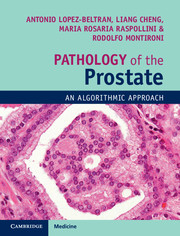Book contents
- Pathology of the Prostate
- Pathology of the Prostate
- Copyright page
- Contents
- Preface
- Chapter 1 Basic Anatomy and Histology of the Prostate
- Chapter 2 Inflammatory and Tumor-like Conditions of the Prostate
- Chapter 3 Preneoplastic Lesions and Conditions of the Prostate
- Chapter 4 Adenocarcinoma of the Prostate
- Chapter 5 Gleason Grading of Prostate Cancer
- Chapter 6 Histologic Subtypes of Prostatic Carcinoma
- Chapter 7 Neuroendocrine Tumors of the Prostate
- Chapter 8 Pathologic Prognostic Factors of Prostate Cancer
- Chapter 9 Pathology of the Prostate after Treatment
- Chapter 10 Basic Molecular Pathology of Prostate Cancer
- Chapter 11 Rare Forms of Prostatic Carcinomas
- Chapter 12 Tumors and Tumor-like Conditions of the Prostate Stroma
- Chapter 13 Soft Tissue and Miscellaneous Primary Tumors of the Prostate
- Chapter 14 Metastatic and Secondary Tumors of the Prostate
- Chapter 15 The Seminal Vesicles and Ejaculatory Ducts
- Chapter 16 Pathology of the Prostatic Urethra
- Chapter 17 Practical Immunohistochemistry of Prostate Cancer and Related Lesions
- Index
- References
Chapter 9 - Pathology of the Prostate after Treatment
Published online by Cambridge University Press: 04 November 2017
- Pathology of the Prostate
- Pathology of the Prostate
- Copyright page
- Contents
- Preface
- Chapter 1 Basic Anatomy and Histology of the Prostate
- Chapter 2 Inflammatory and Tumor-like Conditions of the Prostate
- Chapter 3 Preneoplastic Lesions and Conditions of the Prostate
- Chapter 4 Adenocarcinoma of the Prostate
- Chapter 5 Gleason Grading of Prostate Cancer
- Chapter 6 Histologic Subtypes of Prostatic Carcinoma
- Chapter 7 Neuroendocrine Tumors of the Prostate
- Chapter 8 Pathologic Prognostic Factors of Prostate Cancer
- Chapter 9 Pathology of the Prostate after Treatment
- Chapter 10 Basic Molecular Pathology of Prostate Cancer
- Chapter 11 Rare Forms of Prostatic Carcinomas
- Chapter 12 Tumors and Tumor-like Conditions of the Prostate Stroma
- Chapter 13 Soft Tissue and Miscellaneous Primary Tumors of the Prostate
- Chapter 14 Metastatic and Secondary Tumors of the Prostate
- Chapter 15 The Seminal Vesicles and Ejaculatory Ducts
- Chapter 16 Pathology of the Prostatic Urethra
- Chapter 17 Practical Immunohistochemistry of Prostate Cancer and Related Lesions
- Index
- References
- Type
- Chapter
- Information
- Pathology of the ProstateAn Algorithmic Approach, pp. 114 - 126Publisher: Cambridge University PressPrint publication year: 2017



